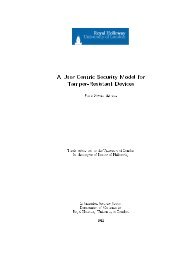Value Hierarchies across Cultures.rtf
Value Hierarchies across Cultures.rtf
Value Hierarchies across Cultures.rtf
- No tags were found...
Create successful ePaper yourself
Turn your PDF publications into a flip-book with our unique Google optimized e-Paper software.
Cross-Cultural Similarities 4why others are assigned lesser importance. Finally, we illustrate, with data from Singapore and from the UnitedStates, how interpretation of the value priorities of a group changes and becomes more informative when wecompare these priorities to the pan-cultural normative baseline.The Set of <strong>Value</strong> TypesWe define values as desirable, transsituational goals, varying in importance, that serve as guidingprinciples in people's lives (see Schwartz, 1992, for a fuller elaboration; cf. Rokeach, 1973 and Kluckhohn, 1951). Thecrucial content aspect that distinguishes among values is the type of motivational goal they express. We derived tenmotivationally distinct types of values intended to be comprehensive of the core values recognized in culturesaround the world from universal requirements of the human condition. These types covered the content categorieswe found in earlier value theories, in value questionnaires from different cultures, and in religious and philosophicaldiscussions of values. We characterize each type of values by describing its central motivational goal. Table 1 liststhe value types, each defined in terms of its central goal. A set of specific single values that primarily represent eachvalue type appear in parentheses, following the definition. A specific value represents a type when actions thatexpress the value or lead to its attainment promote the central goal of the type.Table 1 about hereMultidimensional analyses of the relations among the single values within each of 47 cultures providedreplications that supported the discrimination of the postulated ten value types (Schwartz, 1992, 1994; Schwartz &Sagiv, 1995). These analyses within each culture also established that the 45 single values listed in Table 1 havenearly equivalent meanings <strong>across</strong> cultures. These 45 values formed consistent and internally reliable subsets thatserve to index the ten value types. 1 To assess the comprehensiveness of the ten value types, we invited researchersto add values of significance in their culture that were missiin the survey. Researchers in each of 18 countries addedup to six values. Analyses including the added values revealed that they correlated with the core values from theappropriate motivational value types, identifying no missing motivational content. This supported the view that theset of ten types probably does not exclude any significant types of basic values. 2 The assumption of near1 For details on the reliability of the value type indexes, see Schmitt, et al. (1993). Note that theachievement value type refers to meeting social standards and attaining social approval, not to meetingpersonal standards. This differs from McClelland's “need for achievement” which resemblesself-direction values (McClelland, Atkinson, Clark, & Lowell, 1953).2 The fact that the multidimensional spatial representation of relations among the singe values revealed noextensive empty regions also supported the argument for comprehensiveness.















